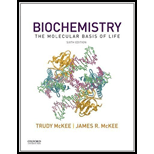
Concept explainers
To review:
The better reducing agent ineach of the given pairs:
NADH/H2O
UQH2/FADH2
Cyt c (reduced)/Cyt b (reduced)
FADH2/ NADH
NADH/ FMNH2
Introduction:
Reduction is a process of the gain of H+ (hydrogen ions) or the loss of O (oxygen), whileoxidation is a process of the gain of oxygen or the loss of hydrogen. Oxidizing agents add an oxygen to another substance or remove a hydrogen from a substance. Reducing agent, sn the other hand, either add a hydrogen or remove an oxygen from a compound.
Explanation of Solution
Better reducing agents out of the mentioned substances in the given pairs of compounds are discussed below:
NADH/H2O: NADH (reduced Nicotinamide adenine dinucleotide)is a better reducing agent because water molecule is considered weak as both, oxidizing as well as reducing agent, as it can reduce only a limited number of substances, whereas NADH can reduce a variety of substances. Moreover, the redox potential of NADH is lower as compared to the water molecules.
UQH2/FADH2: UQH2(Ubiquinol-10-reduced) is a better reducing agent because it can easily propagate electrons from complex I. Moreover, its redox potential is significantly lower than the FADH2 moiety.
Cyt c (reduced)/Cyt b (reduced): Cyt b (Cytochrome b), in its reduced form, is a better reducing agent because it can easily liberate electrons to reduce cytochrome a and has a much lower reduction potential than Cyt c.
FADH2/NADH: NADH (Nicotinamide adenine dinucleotide) is a better reducing agent than FADH2 (Flavin adenine dinucleotide) because of its lower reduction potential value and the ability to easily liberate electrons.
NADH/FMNH2: FMNH2 (flavin mononucleotide) is a better reducing agent than NADH ((Nicotinamide adenine dinucleotide) because of the fact that it can easily donate electrons and has a considerably lower reduction potential.
Therefore, it can be concluded that the ability to act as a reducing agent depends on the intricate reduction potential of a chemical species. In case a chemical species has a high reduction potential, it has a strong affinity for electrons, while a low reduction potential facilitates easy liberation of electrons. The liberated electrons can be used to reduce other molecules and therefore, a low reduction potential value confers higher reducing capabilities.
Want to see more full solutions like this?
Chapter 10 Solutions
Biochemistry, The Molecular Basis of Life, 6th Edition
- You’ve isolated a protein and determined that the Native molecular weight of the holoenzyme is 160 kD using size exclusion chromatography. Analysis of this protein using SDS-PAGE revealed 2 bands, one at 100 kD and one at 30 kD. The enzyme was found to be 0.829% NAD (by weight). What further can be said regarding the structure of the polypeptide?arrow_forwardWhat is the formation of glycosylated hemoglobin (the basis for the HbA1c test)? Can you describe it?arrow_forwardPlease analze the gel electrophoresis column of the VRK1 kinase (MW: 39.71 kDa). Also use a ruler to measure the length of the column in centimeters and calculate the MW of each band observed. Lane 1: buffer Lane 2 : Ladder Lane 3: Lysate Lane 4: Flowthrough Lane 5: Wash Lanes 6-8: E1, E2, E3 Lane 9: Dialyzed VRK1 Lane 10: LDHarrow_forward
- Do sensory neurons express ACE2 or only neurolipin-1 receptors for COVID19 virus particle binding?arrow_forwardExplain the process of CNS infiltration of COVID19 through sensory neurons from beginning to end, including processes like endocytosis, the different receptors/proteins that are involved, how they are transported and released, etc.,arrow_forwardH2C CH2 HC-COOO CH2 ܘHO-C-13c-O isocitrate C-S-COA H213c CH2 C-OO 13C-S-COA CH2 C-00 the label will not be present in succinyl CoA C-S-COA succinyl-CoAarrow_forward
- A culture of kidneys cells contains all intermediates of the citric acid cycle. It is treated with an irreversible inhibitor of malate dehydrogenase, and then infused withglucose. Fill in the following list to account for the number of energy molecules that are formed from that one molecule of glucose in this situation. (NTP = nucleotidetriphosphate, e.g., ATP or GTP)Net number of NTP:Net number of NADH:Net number of FADH2:arrow_forward16. Which one of the compounds below is the final product of the reaction sequence shown here? OH A B NaOH Zn/Hg aldol condensation heat aq. HCI acetone C 0 D Earrow_forward2. Which one of the following alkenes undergoes the least exothermic hydrogenation upon treatment with H₂/Pd? A B C D Earrow_forward
- 6. What is the IUPAC name of the following compound? A) (Z)-3,5,6-trimethyl-3,5-heptadiene B) (E)-2,3,5-trimethyl-1,4-heptadiene C) (E)-5-ethyl-2,3-dimethyl-1,5-hexadiene D) (Z)-5-ethyl-2,3-dimethyl-1,5-hexadiene E) (Z)-2,3,5-trimethyl-1,4-heptadienearrow_forwardConsider the reaction shown. CH2OH Ex. CH2 -OH CH2- Dihydroxyacetone phosphate glyceraldehyde 3-phosphate The standard free-energy change (AG) for this reaction is 7.53 kJ mol-¹. Calculate the free-energy change (AG) for this reaction at 298 K when [dihydroxyacetone phosphate] = 0.100 M and [glyceraldehyde 3-phosphate] = 0.00300 M. AG= kJ mol-1arrow_forwardIf the pH of gastric juice is 1.6, what is the amount of energy (AG) required for the transport of hydrogen ions from a cell (internal pH of 7.4) into the stomach lumen? Assume that the membrane potential across this membrane is -70.0 mV and the temperature is 37 °C. AG= kJ mol-1arrow_forward
 Concepts of BiologyBiologyISBN:9781938168116Author:Samantha Fowler, Rebecca Roush, James WisePublisher:OpenStax College
Concepts of BiologyBiologyISBN:9781938168116Author:Samantha Fowler, Rebecca Roush, James WisePublisher:OpenStax College BiochemistryBiochemistryISBN:9781305577206Author:Reginald H. Garrett, Charles M. GrishamPublisher:Cengage LearningBasic Clinical Lab Competencies for Respiratory C...NursingISBN:9781285244662Author:WhitePublisher:Cengage
BiochemistryBiochemistryISBN:9781305577206Author:Reginald H. Garrett, Charles M. GrishamPublisher:Cengage LearningBasic Clinical Lab Competencies for Respiratory C...NursingISBN:9781285244662Author:WhitePublisher:Cengage





